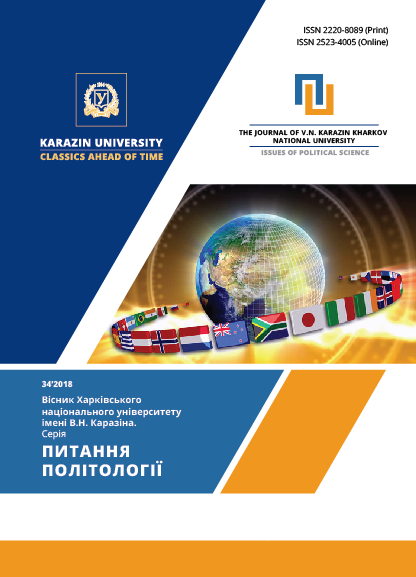CONCEPTUALIZATION OF ALLIANCES IN INTERNATIONAL RELATIONS THEORY
Abstract
Ukraine's decision to drop non-aligned status was done as the result of a growing understanding of an urgent need to find more effective means to protect the state from external aggression. One of the main means is integration into powerful intergovernmental institutions, primarily, to European and Euro-Atlantic ones. Thus, acquiring membership in the European Union and the North Atlantic Treaty Organization (NATO) is now among the priorities of Ukraine's foreign policy. In the process of growing global interdependence, alliances gradually become the main form of international cooperation. At the same time, they are increasingly associated with the emergence and spread of wars and conflicts, as well as their prevention. Under the difficult conditions of international interaction, numerous threats to the existence of state, the implementation of state’s foresightful foreign policy depends on the adequacy of understanding of the nature of cooperation and conflict in relations between states by state’s leadership. Therefore, it is vital to expand and deepen the knowledge about the peculiarities of the formation and functioning of alliances, and the behavior of their participants while contacting each other. The concept of alliances lies at the core of the theory of international relations, since alliances can be considered as a means of implementing the foreign policy of the state, and at the same time as vivid indicators for the implementation of mutual obligations by states. The article deals with the key theoretical contributions on conceptualization of the international alliances as one of the main forms of intergovernmental cooperation. The author provides a general overview of academic papers on alliance theory and uncover the main peculiarities of the periods of research on alliance in political science during and after the Cold War. The article discusses main approaches of the international relations theory to the definition of alliances, as well as the prevailing typologies of alliances.
Downloads
References
Bergsmann, Stefan. 2001. “The Concept of Military Alliance”. In: Erich Reiter• Heinz Gartner (Editors). Small States and Alliances. Springer-Verlag Heidelberg: 20–31. URL: http://www.bildungundberuf.atwww.bundesheer.at/pdf_pool/publikationen/05_small_states_04.pdf (дата звернення 19.11.2018).
Snyder, Glenn H. 1991. “Alliances, balance, and stability“. International Organization. 45(01): 121-142. URL: https://www.jstor.org/stable/2706698? seq=1#page_scan_tab_contents (дата звернення 10.11.2018).
Gaertner, Heinz. 2001. “Small States and Alliances”. In: Reiter, Erich, Gärtner, Heinz (Eds.). Small States and Alliances. Physica-Verlag Heidelberg: 1-11. URL: http://www.hgm-wien.at/pdf_pool/publikationen/05_small_states_01.pdf (дата звернення 1.11.2018).
Kajsa Ji Noe Oest, 2007. The End of Alliance Theory? A Literature Review of Realist Alliance Theory. Institut for Statskundskab, Københavns Universitet, Arbejdspapir. URL: http://polsci.ku.dk/arbejdspapirer/2007/ap_2007_03.pdf (дата звернення 15.11.2018).
Snyder, Glenn H. 1997. Alliance Politics, Ithaca. New York: Cornell University Press.
Bennett, D. Scott. 1997. “Testing Alternative Models of Alliance Duration, 1816-1984”. American Journal of Political Science 41(3): 846-878. URL: https://www.jstor.org/stable/2111677?seq=1#page_scan_tab_contents (дата звернення 19.10.2018).
Walt, Stephen. 1987. “The Origins of Alliances”. Ithaca: Cornell University Press.
Waltz, Kenneth. 1979. Theory of International Politics. New York: Random House. URL: http://ru.scribd.com/doc/40007016/Kenneth-Waltz-Theory-of-International-Politics (дата звернення 15.10.2018).
Singer, J. David and Small, Melvin. 1966. “Formal Alliances, 1815-1939: A Quantitative Description”. Journal of Peace Research 3(1): 1–32. URL: http://deepblue.lib.umich.edu/bitstream/handle/2027.42/68798/10.1177_002234336600300101.pdf?sequence=2 (дата звернення 19.10.2018).
Mearsheimer, John J. 2001. “The Tragedy of Great Power politics”. New York: W.W. Norton. URL: https://samuelbhfauredotcom.files.wordpress.com/2015/10/s2-mearsheimer-2001.pdf (дата звернення 23.11.2018).
Author’s copyright and licensing.
License Terms: Authors retain copyright and also grant the Journal the right to publish original scientific articles that contain research results and are not under consideration for publication in other issues. All material is licensed under a Creative Commons Attribution License International CC-BY, which allows others to distribute their work with the copyright of this work and recognition of the first publication in this Journal.
If the article is taken for publishing in The Journal of V.N. Karazin Kharkiv National University. “Political Science Issues”, the author must sign a copyright transfer agreement. The agreement is sent by post (original document) or by e-mail (scanned copy of the document) to the Editorial Board of the Journal.
By this agreement the author certifies that the submitted material:
- does not violate the copyrights of other people or organizations;
- has not been previously published in other issues and has not been given for publishing to other issues.
The author gives the editorial board the rights to:
- publish the article in Ukrainian (English) and distribute its printed version;
- translate the article into English (for articles in Ukrainian) and distribute the printed version of the translation;
- distribute the electronic version of the article, as well as the electronic version of the English-language translation of the article (for articles in Ukrainian and Russian), through any electronic means (placing on the official journal web site, in electronic databases, repositories, etc.).
The author reserves the right without the consent of the editorial board and the founders to:
- Completely or partly use the materials of the article for educational purposes.
- Completely or partly use the materials of the article for writing own theses.
- Use the materials of the article to prepare abstracts, conference reports, and oral presentations.
- Post electronic copies of the article (including the final electronic version downloaded from the journal's official website) to:
- personal web-resources of all authors (web sites, web pages, blogs, etc.);
- web-resources of institutions where authors work (including electronic institutional repositories);
- non-profit, open-source web resources (such as arXiv.org).




